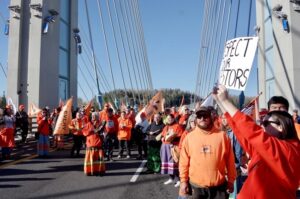Red Rock Indian Band holds peaceful protest

By Rick Garrick
RED ROCK INDIAN BAND – Red Rock Indian Band held a peaceful protest on Oct. 21 at the Nipigon River Bridge and Highways 11 and 17 intersection over their hindered search for Indigenous Ancestors that were uncovered at a Parks Canada construction site in May and displaced throughout Nipigon. Carbon dating on one Ancestor confirmed that the Ancestor was buried before contact, in about 1404 AD.
“I believe we got our word out because when we first said we were going to go and block the bridge, they had 80-100 police staged in Nipigon,” says Red Rock Indian Band Chief Allan Odawa Jr. “We negotiated with the OPP (Ontario Provincial Police) saying, ‘Give us the north bridge, we can slow traffic down in a safe manner, hand out our information pamphlets, and then we can continue on,’ which is what happened. We’re just wrapping up now, no one got hurt, I believe our information got out along with the media and the public that’s passing through today.”
The remains of four Indigenous ancestors were uncovered during the excavation of the site for Parks Canada’s $37 million dollar Administration and Visitor Centre for the Lake Superior National Marine Conservation Area in Nipigon, but the remains were incomplete. An estimated 150 loads of earth were moved from the site and relocated to multiple locations throughout Nipigon before an environmental monitor for Red Rock Indian Band who was on site could take action, and about 60 of the loads are still unaccounted for as of Oct 15. Because no remains have been found since August, the community believes the missing remains could be in the 60 loads of earth.
“Hopefully what we get out of this is that this never happens again — the Burial Unit should have been involved right away,” Chief Odawa Jr. says. “There’s four Ancestors that were uncovered, so we’re just searching for the remains, and once that happens, we’re going to reinsert them and have a four-day ceremony down at the marina. It was very frustrating because you shouldn’t have to go to this extreme to get any action.”
Anishinabek Nation Deputy Grand Council Chief Chris Plain, Anishinabek Nation Northern Superior Regional Chief Mel Hardy, Fort William Chief Michele Solomon, and Biinjitiwaabik Zaaging Anishinaabek Chief Gladys Thompson were among the supporters who marched with Chief Odawa Jr. during the walk from the Red Rock Indian Band office to the northern bridge, the Hwy. 11 and 17 intersection, and then back to the community’s Chalet Lodge for a luncheon feast.
“I’m just wondering why we’re here, why we have to get to this point,” Deputy Grand Council Chief Plain says. “As you see, there’s a very diverse crowd here, there’s Elders, there’s traditional people, there’s community members, but there is no youth. I understand that was a decision to keep their children away from the heavy OPP presence here and I just wonder why we’re restricted in our movements and restricted in our protest.”
“There’s a big crowd,” Northern Superior Regional Chief Hardy says. “People are sick and tired of the actions that’s being taken towards our people, especially when we talk about our human remains. I was [at the site] and there were bone fragments spread all over the lot.”
“If it was happening in my community, I would want the support of the Regional Chief and the Chiefs in the area to be there to stand together because together we are strong,” Chief Solomon says. “The community members want the remains of our people to be brought home, they want them to be in their proper resting place, which they should be.”
“They continued to work when they found the remains and that’s not right, they should have stopped everything all together,” Chief Thompson says. “So that’s why I’m here supporting, I think it’s for a good cause so that we can reach out to all of Canada that’s watching and let them know that we care for our community and our families.”
Parks Canada states that archaeological assessments on the property, including more than 80 archaeological test pits, were reviewed as part of the Impact Assessment requirements for the project in a statement.

